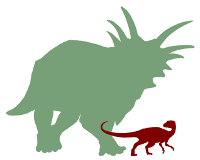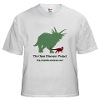After all of this work and data accumulation, it’s probably just about time to do the darned analyses and write the darned paper. We’ve had quite a bit of discussion over the last year or so on what this might look like. To that end, I want to outline one possibility and then solicit input from everyone. Again, this is very much a work in progress, so please comment as appropriate.
Working Title: Trends and Variation in Limb Proportions of Ornithischian Dinosaurs [please think up a more exciting, succinct, and descriptive title]
Outline of Contents
- Introduction
What are ornithischian dinosaurs?
What do we already know about their modes of locomotion and limb proportions? How are they unusual compared to other dinosaurs?
What have other workers done with analyzing dinosaurian limb proportions?
What is the main point of this study? [to document, describe, and interpret ornithischian limb morphology, and how it relates to function] - Materials and Methods
Jay Fitzsimmon’s very nice paragraph on citizen science and the ODP goes here.
How specimens were selected.
Where we got the measurements.
How we winnowed down the data.
How we assembled the phylogeny
Statistical analyses performed on the data [PCA to describe overall patterns; regressions accounting for phylogeny to describe various allometric patterns {we probably only want to look at patterns that are comparable with theropods or other analyses of interest}; analyses looking at trends within clades; analysis of disparity; analysis comparing characters using phylogenetically independent contrasts] - Results
Principal components analysis – done on uncorrected data, how do we describe the limb proportions in various ornithischians. Believe it or not, this hasn’t really been done!
Regressions accounting for phylogeny to describe allometric patterns – we might want to look at a few regressions, such as forelimb vs. hindlimb length, femur vs. tibia+MTIII, humerus vs. radius+MCIII
Analysis documenting trends in clades – include pretty colored images a la Padian et al’s charts of dinosaurian growth rates
Analysis of disparity – how disparate are various groups? How rapidly did the bauplans for the various groups develop? - Discussion & Conclusions
What do these results mean?
We’ll have more to fill in when we get some “final” results!
A Recommendation:
We all will have an urge to make this paper as absolutely comprehensive as possible – in the past we have talked about many, many different kinds of analyses, hypotheses, etc. But, I think we also want to avoid getting bogged down in needless detail or bloated and waylaid by side tangents of marginal importance. (some of what I outlined above may very well fall into this category!) So, let’s keep that in mind. . .(but don’t be afraid to make suggestions, either!)




On the subject of Andy’s Recommendation here: I do agree it’s important that we keep this paper reasonably tightly focussed. BUT for those of you with ideas that are relevant but not core, this is good news, not bad. We actively welcome any number of additional papers, based on the same data-set as this one, and doing new and exciting things with it. All we ask is that you not submit your ODP-based paper to a journal until this first paper comes out, so that we as a group get visible priority. But after that, heck, the more ideas this data allows us all to come up with an test, the better!
For the trends in clades – we might think about doing analyses comparing different characters (i.e. a forelimb ratio to a hindlimb ratio) using methods such as phylogenetic independent contrasts to see if their correlation is significant, and other phylogenetic comparative tests to see if they shift in values significantly at the same points in the phylogeny. One could also use this to test hypotheses, such as comparing a key ratio/measurement to where we infer quadrupedality, to see if there is actually a statistically significant correlation.
Possible (though probably not exciting) title: “Morphometrics of the limbs of ornithischian dinosaurs: implications for the evolution of secondary quadrupedality”
Excellent suggestions, all.
As per Mike’s comment above, I agree that more focusing is necessary to present (perhaps selectively) our data. However, the two working titles suggested have slightly different contents. Andy’s original suggests that we only contrast against the major groups/clades within Ornithischians, while the other would suggest an additional focus on early ornithischians where secondary quadrupedality (as a null hypothesis) evolved. I suspect that, for the latter, the conclusion reached might be weak, since at present we do not have data on sauropodomorphs to double check if dinosaurs follow some general rules and constraints in their evolution of secondary quadrupedality.
Leo,
I’m not sure I catch your drift. The shift to qadrupedality in ornithischians did not only happen early on in their history. There are many bipedal ornithischians in our dataset. We actually do have some basal sauropodomorphs and theropods in the dataset for outgroup comparison.
We’re not saying that we are going to analyze all of Dinosauria. Rather, we can say that ornithischians are a great study clade because they show multiple shifts towards quadrupedality. Did all quadrupedal ornithischian clades do it the same way? What differences do we see across Ornithischia independent of locomotor strategy.
I’m not necessarily advocating for my title – it could suck, and may not be what we want. But I don’t think it implies we are just looking at early ornithischians and/or need extensive sauropodomorph datasets.
This is a really interesting and valuable comment. I had made my original comment based on my personal view that MOST ornithischians (perhaps besides those outside Genusauria, and heterodontosaurs) should be reconstructed as quadrupedal. Fair to say, I am a paleo-artist.
If one asks: “Which ornithischians were bipedal?” The answer is – with the advent of time – simply put, “less and less”. If you were to ask Dollo, Iguanodons were “of course” bipedal (and the stupid Crystal Palace models were plain wrong, right?). If you were to ask Leidy, Hadrosaurus were “of course” bipedal. For the first seventy years known to modern science, Protoceratops were bipedal. Even as late as Norman (1985, Encyclopedia of the dinosaurs), Iguanodon was recontructed as bipedal. Charles R Knight was once more ambivalent in his painting of edmontosaurs, reconstructing one as bipedal and the other quadrupedal. Perhaps largely due to the influenced of Greg Paul, we nowadays would find MOST ornithischians “naturally” quardupedal.
The conclusions?
(1) The aforementioned historical skew have greatly influenced our recontruction of the “evolution of secondary quadrupedality in ornithischians”. This is certainly worthwhile to comment about this historical note in our paper.
(2) Do we have any objective criteria in determining (in a non a priori manner) which ornithischian clades were quadrupedal besides employing limb proportion data? Otherwise our arguments would be circulatory.
Hi everyone,
Now that it’s summer and the Spring term is over, would it be a good time to start up work on the paper again?
@David
Sounds like a plan. What parts need writing up?
@220mya
It seems to me that the only confirmed quadrupeds would be those for whom biophysical considerations would rule out bipedality as well as those clades represented by quadrupedal ichnofossils.
Hi Dave–
Much agreed. Thanks for the nudge; Matt and Mike have been nudging me too, so I guess it’s time I get off my butt and do something! (and you are right – the academic year is finally drawing to a close, so my time is opening up a little bit).
We should have a post soon!
Pingback: Summertime, open ignorance, and finishing the project « The Open Dinosaur Project
” Do we have any objective criteria in determining (in a non a priori manner) which ornithischian clades were quadrupedal besides employing limb proportion data?”
There is extensive evidence for most clades in the fossil footprint record (maybe), e.g.
Martin G. Lockley, Richard T. McCrea and Masaki Matsukawa. 2009. “Ichnological evidence for small quadrupedal ornithischians from the basal Cretaceous of SE Asia and North America: implications for a global radiation.” Geological Society, London, Special Publications 2009, v. 315, p. 255-269
Niedźwiedzki, G. 2011. A Late Triassic dinosaur−dominated ichnofauna from the Tomanová Formation of the Tatra Mountains, Central Europe. Acta Palaeontologica Polonica 56: 291–300. doi:10.4202/app.2010.0027
Martin Lockley and Christian Meyer. 2000. Dinosaur Tracks and Other Fossil Footprints of Europe. Columbia University Press. New York.
Martin Lockley and Judy Peterson. 2002. A guide to Fossil Footprints of the World Dinosaur Ridge.
Gerard D. Gierliński and Karol Sabath. 2008. Stegosaurian footprints from the Morrison Formation of Utah and their implications for interpreting other ornithischian tracks.
Thanks for the references, Hector! The footprint record is going to have to do for most cases (although unfortunately there’s not much for some clades).